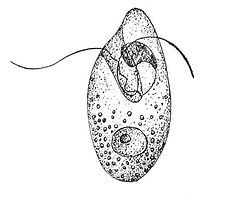
Summary
Los miozoos (Miozoa) son un filo de protistas alveolados unicelulares[1] generalmente flagelados y de hábitat marino principalmente, que poseen alvéolos corticales como parte de su estructura celular. Dentro de Alveolata constituye el clado principal hermano de Ciliophora y es muy diverso, pues está conformado por grupos fotosintéticos como Dinoflagellata y Chromerida, por heterótrofos que pueden ser endoparásitos como Apicomplexa y Perkinsozoa y otros grupos predadores de vida libre.[2]
| Miozoa | ||
|---|---|---|
 | ||
| Taxonomía | ||
| Dominio: | Eukaryota | |
| Reino: | Protista | |
| (sin rango) | Harosa | |
| Superfilo: | Alveolata | |
| Filo: |
Miozoa Cavalier-Smith, 1987 | |
| Subgrupos | ||
| ||
Conforma un grupo grande con unas 8.000 especies descritas, muchas de las cuales presentan complejo apical o se alimentan por mizocitosis. Los miozoos más tempranos son llamados protalveolados, los cuales presentan características ancestrales como la de ser biflagelados acuáticos, rápidos nadadores y predadores.
Miozoa se ha definido por una condición típicamente haploide, mientras que en el otro filo Ciliophora hay micronúcleos diploides y macronúcleos multiploides.[3] Además se caracterizan por tener crestas mitocondriales ampulares.[4]
Filogenia
editarEl análisis genético a nivel de las subunidades mayor y menor del ADNr nuclear han dado el como resultado las siguientes relaciones filogenéticas:[5][6]
| Alveolata |
| ||||||||||||||||||||||||||||||||||||||||||
Referencias
editar- ↑ Miozoa. The Taxonomicon.
- ↑ T. Cavalier-Smith & E. Chao 2004, Protalveolate phylogeny and systematics and the origins of Sporozoa and dinoflagellates (phylum Myzozoa nom. Nov.) European Journal of Protistology 40(3):185-212 · 2004 DOI: 10.1016/j.ejop.2004.01.002
- ↑ Cavalier-Smith, T. (2002). The phagotrophic origin of eukaryotes and phylogenetic classification of Protozoa. International Journal of Systematic and Evolutionary Microbiology (2002), 52, 297–354 DOI: 10.1099/ijs.0.02058-0
- ↑ Thomas Cavalier-Smith 2017, Kingdom Chromista and its eight phyla: a new synthesis emphasising periplastid protein targeting, cytoskeletal and periplastid evolution, and ancient divergences Protoplasma, January 2018, Volume 255, Issue 1, pp 297–357
- ↑ Robert B. Moore et al 2008. A photosynthetic alveolate closely related to apicomplexan parasites Nature 451, 959-963 doi:10.1038/nature06635. Según árbol Nuclear and plastid phylogenies of Chromera velia.
- ↑ Tikhonenkov, D. V., Janouškovec, J., Mylnikov, A. P., Mikhailov, K. V., Simdyanov, T. G., Aleoshin, V. V., & Keeling, P. J. (2014). Description of Colponema vietnamica sp. n. and Acavomonas peruviana n. gen. n. sp., two new alveolate phyla (Colponemidia nom. nov. and Acavomonidia nom. nov.) and their contributions to reconstructing the ancestral state of alveolates and eukaryotes. PloS one, 9(4).


